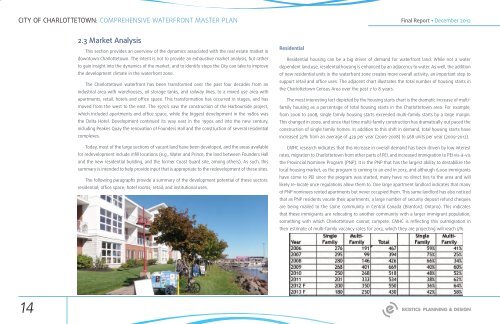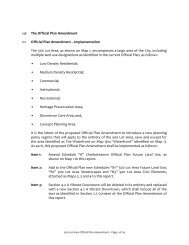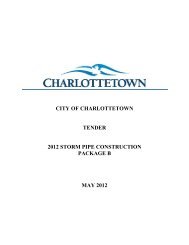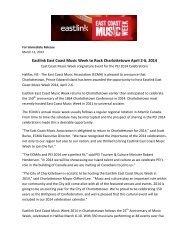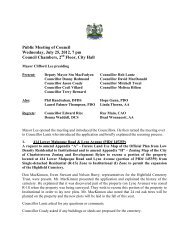Final Report - City of Charlottetown
Final Report - City of Charlottetown
Final Report - City of Charlottetown
- No tags were found...
You also want an ePaper? Increase the reach of your titles
YUMPU automatically turns print PDFs into web optimized ePapers that Google loves.
CITY OF CHARLOTTETOWN: COMPREHENSIVE WATERFRONT MASTER PLAN<strong>Final</strong> <strong>Report</strong> • December 20122.3 Market AnalysisThis section provides an overview <strong>of</strong> the dynamics associated with the real estate market indowntown <strong>Charlottetown</strong>. The intent is not to provide an exhaustive market analysis, but ratherto gain insight into the dynamics <strong>of</strong> the market, and to identify steps the <strong>City</strong> can take to improvethe development climate in the waterfront zone.The <strong>Charlottetown</strong> waterfront has been transformed over the past four decades from anindustrial area with warehouses, oil storage tanks, and railway lines, to a mixed use area withapartments, retail, hotels and <strong>of</strong>fice space. This transformation has occurred in stages, and hasmoved from the west to the east. The 1970’s saw the construction <strong>of</strong> the Harbourside project,which included apartments and <strong>of</strong>fice space, while the biggest development in the 1980s wasthe Delta Hotel. Development continued its way east in the 1990s and into the new century,including Peakes Quay the renovation <strong>of</strong> Founders Hall and the construction <strong>of</strong> several residentialcomplexes.Today, most <strong>of</strong> the large sections <strong>of</strong> vacant land have been developed, and the areas availablefor redevelopment include infill locations (e.g., Water and Prince, the land between Founders Halland the new residential building, and the former Coast Guard site, among others). As such, thissummary is intended to help provide input that is appropriate to the redevelopment <strong>of</strong> these sites.The following paragraphs provide a summary <strong>of</strong> the development potential <strong>of</strong> these sectors:residential; <strong>of</strong>fice space; hotel rooms; retail; and institutional uses.ResidentialResidential housing can be a big driver <strong>of</strong> demand for waterfront land. While not a waterdependent land use, residential housing is enhanced by an adjacency to water. As well, the addition<strong>of</strong> new residential units in the waterfront zone creates more overall activity; an important step tosupport retail and <strong>of</strong>fice uses. The adjacent chart illustrates the total number <strong>of</strong> housing starts inthe <strong>Charlottetown</strong> Census Area over the past 7 to 8 years.The most interesting fact depicted by the housing starts chart is the dramatic increase <strong>of</strong> multifamilyhousing as a percentage <strong>of</strong> total housing starts in the <strong>Charlottetown</strong> area. For example,from 2006 to 2008, single family housing starts exceeded multi-family starts by a large margin.This changed in 2009, and since that time multi-family construction has dramatically out paced theconstruction <strong>of</strong> single family homes. In addition to this shift in demand, total housing starts haveincreased 32% from an average <strong>of</strong> 429 per year (2006-2008) to 568 units per year (2009-2012).CMHC research indicates that this increase in overall demand has been driven by low interestrates, migration to <strong>Charlottetown</strong> from other parts <strong>of</strong> PEI, and increased immigration to PEI vis-à-visthe Provincial Nominee Program (PNP). It is the PNP that has the largest ability to destabilize thelocal housing market, as the program is coming to an end in 2013, and although 6,000 immigrantshave come to PEI since the program was started, many have no direct ties to the area and willlikely re-locate once regulations allow them to. One large apartment landlord indicates that many<strong>of</strong> PNP nominees rented apartments but never occupied them. This same landlord has also noticedthat as PNP residents vacate their apartments, a large number <strong>of</strong> security deposit refund chequesare being mailed to the same community in Central Canada (Branford, Ontario). This indicatesthat these immigrants are relocating to another community with a larger immigrant population;something with which <strong>Charlottetown</strong> cannot compete. CMHC is reflecting this outmigration intheir estimate <strong>of</strong> multi-family vacancy rates for 2013, which they are projecting will reach 5%.14


